No one could accuse the company of not ‘thinking big’ when they
scheduled Aida as the showpiece of the 2012 season. Is there any piece
that screams ‘Grand Opera’ quite as loudly? And is there any theatre more
intimate than the Alice Busch, with its 910 seats, smallish stage, and even
smaller pit?
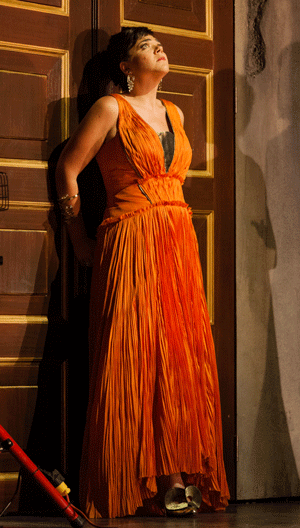 Daveda Karanas as Amneris
Daveda Karanas as Amneris
Ms. Zambello turned these limitations into a distinct advantage by first
divesting the piece of the usual ‘Egyptiana.’ Gone were the replications of
temples and friezes and Nile dress and pageantry. For the director-designers
have focused on the intimate love triangle and placed it in the context of the
Arab Spring.
Set designer Lee Savage has located the action in a finely detailed
bombed-out palace. After the prelude, sounds of warfare cause a group of rebels
to seek shelter in the ruin, and subsequently to convert it (perhaps a bit too
quickly) into a cyber-command center setting up chairs and tables laden with
computers. Amneris’ boudoir (apparently in a less damaged portion of the
building) is created with the addition of a beautifully dressed
‘Queen’-size bed, and the addition of luxuriously gowned ladies in waiting,
looking like a bevy of bridesmaids in their South East Asia-inspired coral
attire.
I quite like the placement of a jeep down right for the Nile scene, on the
hood of which warriors strategized over a map of the region. The vehicle also
afforded some interesting blocking opportunities as Radames and Aida sat in it
and on it, and themselves regarded the map as Radames betrays the geographic
placement of the rebel forces.
Bibhu Mohapatra has crafted an effective costume plot rife with bold
choices. The Nubians were attired in modern adaptations of traditional regional
dress, pure white flowing garments accented with blood red belts, trim and
emblems. In the final two acts, princess Amneris showed up in a form fitting
black sequined “wedding” dress that communicated ‘black widow.’ The
King was in a thuggish North African leopard skin-accented Bad-Ass Gangsta
ensemble. Overall, the dress suggested mid-eastern finery and/or
commando/insurgent wear straight out of today’s news. Best of all, Ms.
Mohapatra’s garb in the Triumphal Scene provided a riot of color that did
much to satisfy expectations of pageantry.
The creative team came up with a viable solution that included a
three-tiered tower that dominated the visual, with the King and Ramfis on top,
Amneris and Radames on the middle level, and the full complement of Young
Artists grouped in bunches for maximum effect on the main floor. Through
well-executed movement (‘blocking by the inch’) Miss Z showed her usual
command of crowd management and devised a masterful ebb and flow that more than
satisfied all our expectations.
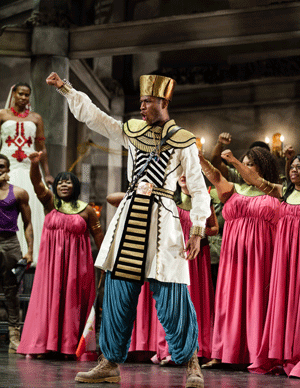 Phillip Gay as the King
Phillip Gay as the King
She was certainly mightily helped in her pursuit by Eric Sean Fogel’s
meaningful choreography, especially the taunting of the captives by aggressive,
hyperactive young men snapping white cloths. Mr. Fogel’s inspired work made
me regret that the Act One ballet was cut. Rounding out the production team,
company treasure Anne Ford-Coates oversaw an effective hair and make-up design
(as she did for all productions). And Robert Wierzel designed highly effective
lighting that not only encompassed the milieu of impending violence and garish
military posturing, but also suggested moments of real serenity with cool
washes. I especially liked the clever shadow screen effect in Act Three.
Nader Abbassi conducted a sensitive, moving account of the score, partnering
beautifully with his soloists and eliciting exciting full-voiced singing from
the amassed forces (David Moody, Chorus Master). Maestro Abbassi also drew
forth intensely hushed choral effects in the Act One Temple Scene that made a
supernatural effect, even competing as they were with a sudden pelting downpour
of rain that hammered the roof. Although this group of musicians was smaller
than we regularly encounter in larger pits, they performed with real
distinction from the sinuous opening prelude, through the boisterous military
scenes, down to the detailed solo work like the exquisite oboe solo in “O
patria mia.”
Speaking of which, Michelle Johnson in the title role reaped a sustained
ovation for her rendition of that aria, one of many highpoints of her
portrayal. Ms. Johnson is possessed of a ripe, round soprano, evenly produced
throughout the range. She has plenty of power to hurl out gleaming top notes
that ride over even the largest ensembles, but can also float ethereal
pianissimo phrases (“Numi, pieta,” to name one) with considerable
distinction. Her chest voice has real firepower but is always well controlled
and well blended into her freely produced technique. Michelle is young and is
still occasionally finding her way through the demanding part, but hers is a
major talent and she will surely evolve into a sought after interpreter of this
iconic role.
When last I heard Noah Stewart, it was as the wholly successful Prince in
The Flowering Tree. But that was a lyrical role that showcased his
sweetness of tone and his beautiful sense of line, all the while capitalizing
on his irresistible charisma and super hero good looks. Radames is a major step
forward for this young talent, which is also to say a major challenge. Mr.
Stewart has evolved into a timbre of polished brass, with clarion power above
the staff, and a personalized, smoky allure in the mid-range. With the
assumption of heavier roles, it has to be said a bit of clumsiness has crept
into the passaggio, with upper ah and oh vowels sometimes turning hard. But I
hasten to add he was always in complete control of his considerable resources.
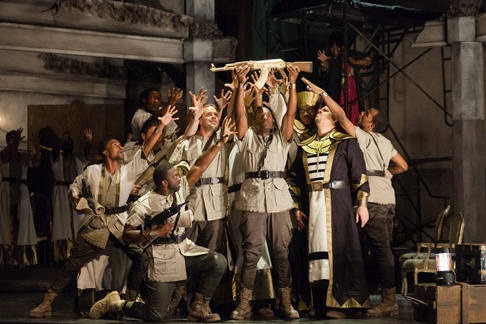 Noah Stewart (center) as RadamËs with members of the ensemble
Noah Stewart (center) as RadamËs with members of the ensemble
Verdi gives our hero a major challenge right at the top of the show, and
“Celeste Aida” was a tad labored and oversold. I might encourage our tenor
to explore the soft option of the ending. Once that aria was dispatched, Noah
relaxed noticeably, the technique settled into place, and he gave much pleasure
with stentorian phrases as well as beautifully negotiated passages at mezzo
forte and softer. ‘O terra addio’ was particularly heartfelt and
affecting.
As Amneris, Daveda Karanas brought an appropriately steely resolve to bear,
and she treated us to a riveting, forceful vocal presence at all pitches and
volumes. Her tortured rendition of a powerful Judgment Scene earned Ms. Karanas
a huge ovation. I wondered if she might not fare even better in a larger house
where the acoustic and some distance might round out the steely vocal presence
a bit.
From the Young Artist Program, Joseph Baron scored with a confident Ramfis,
a role that perfectly suited his rolling, imposing baritone. Clay Hilley gave
us a memorable Messenger, solidly sung with a secure, penetrating tenor. Philip
Gay as the King showed great promise with his pleasing, reliable bass. And
Lenora Green made the most of her brief turn as the Priestess, her lush soprano
making us wish the character had more to sing.
It is a testament to the quality level of the other principals that the
incomparable Eric Owens did not throw the balance of the show off kilter with
his winningly performed Amonasro. This was Mr. Owens’ first attempt at the
part, and based on his total success, it will not be his last. With his
entrance, his rich, powerful, imperious vocalizing raised the bar to an even
higher level, and his colleagues responded to the challenge.
There is no question that Ms. Zambello’s artistic commitment was the
primary cause for the production’s success. There were some controversial
touches to be sure. The water boarding of Radames was not quite truthful for
the Judgment Scene narrative but the ‘truth’ is it was a moment of powerful
resonance nonetheless. There was also debate about Radames’ execution by
lethal injection (shades of Sellars’ Theodora!). Aida subsequently
injects herself, unstraps the dying hero from the table and the two expire in
spasms without being able to physically entwine in a final embrace. Risky, yes.
Different, yes. But when the results are so incredibly moving, who needs
elephants?
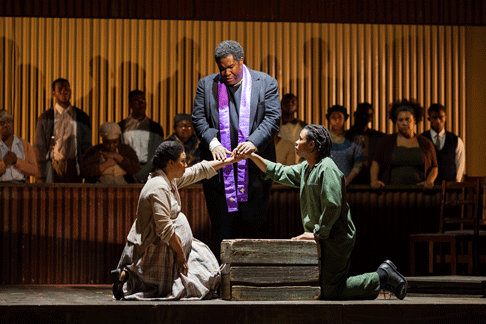 L to R: Brandy Lynn Hawkins as Irina, Eric Owens as Stephen Kumalo and Makudupanyane Senaoana as Absalom
L to R: Brandy Lynn Hawkins as Irina, Eric Owens as Stephen Kumalo and Makudupanyane Senaoana as Absalom
Having sung the matinee Aida, Eric Owens was back on stage that
very evening gifting us with a Herculean achievement in Lost in the
Stars. Mr. Owens was quite simply a force of nature, his compelling
singing, unaffected acting and suggestion of an Afrikaner accent committed and
honest. His singing this night had no equal and he rang down the Act One
curtain with a searing sustained high note so anguished and powerful it may be
resounding still. In Act Two Eric brought down what was left of the house with
an extended aria that was a miraculous blend of lucid narrative and
concentrated emotional journey.
Sean Pannikar was also excellent as the Leader, his solid tenor soaring
easily over the full-throated choruses. Mr. Pannikar was instrumental in the
profound impact of “Cry, the Beloved Country.” As Irina, Brandy Lynn
Hawkins, a sympathetic actress, deployed a rounded lyric soprano to affecting
purpose in “Stay Well”. As the selfish brother John, Amos Nomnabo’s
mellow delivery was characterized by an appealing fast and tight vibrato, an
ironic aural counterpart to his dramatic mal-intent. Makudupanyane Senaoana‘s
Absalom was so wonderfully winning that it was a shame he had nothing to sing.
Tazewell Thompson is a director of such taste and imagination that he made
the whole meticulously coordinated evening seem improvised, spontaneous and
effortless. The book is undeniably problematic, often repetitive, with scenes
occasionally overlong. Sometimes musical moments are too infrequent. But Mr.
Thompson compensates with focused direction, devising seamless transitions that
inventively incorporate the excellent chorus (Mr. Moody again). He devises
alternating moments of excited , well-choreographed motion, and reflective,
sometimes painful repose. Choreographer Anthony Salatino supported Tazewell’s
vision with apt period choreography, especially for the naughty “Who’ll
Buy.”
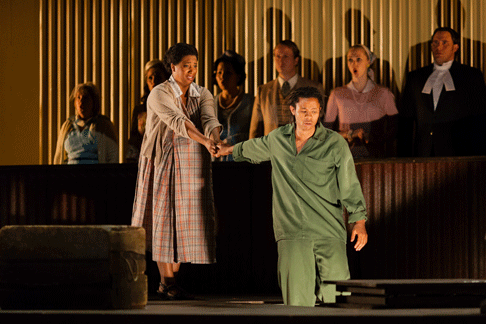 Brandy Lynn Hawkins as Irina and Makudupanyane Senaoana as Absalom
Brandy Lynn Hawkins as Irina and Makudupanyane Senaoana as Absalom
Too, this was an exceptionally effective physical production. Set and
costume designer Michael Mitchell has created handsome unit set that not only
gets re-dressed efficiently to suggest various locales, but also has a treasure
trove of hidden delights, like a kitchen unit revealed by lighting through the
slats in the basic box, and a wondrous suggestion of clouds with the hanging
laundry (white sheets) that frames “Stay Well.” With utmost economy of
gesture the space becomes a church, a speak easy, a courtroom, a train, all
with the simple addition/removal of a handful of chairs. A trapdoor suggests
Absalom’s prison. Mr. Mitchell’s period costumes were also well-considered
and character specific.
The story of apartheid and repression is sadly still relevant. But Lost
in the Stars also embodies themes of redemption and deliverance that are
important, welcome, and cathartic. There was audible weeping in the house at
the conclusion as the father of the murdered boy comforts and cradles the
grief-stricken father of the murderer. This was powerful lyric theatre of the
top tier. John DeMain conducted a straightforward, idiomatic reading of
Weill’s score.
Lully’s seldom performed Armide was lavished with an arresting
set design from Gerard Gauci, colorful and varied, starting with a show drop
scrim based on fanciful calligraphy and symbols. The drops and flown legs were
sparkling with eye-catching Muslim decorative touches, complemented by
twinkling lights and even blazing fires. Bonnie Beecher provided a
multi-faceted lighting design complete with storm and transformation effects,
and good uses of gobos and area lighting.
Dora Rust D’Eye’s elaborate costumes defied period but suggest a sort of
generic, timeless jewel-toned southeast Asian splendor and revelry, to include
Batik’d and tie-dyed tights. Ms. D’Eye certainly took full advantage of the
wonderful physiques of her actors and provided a costume plot full of erotic
imagery. Caveat: the bare-shouldered look for the heroine with its push up bra
and generous dÈcolletage became a distraction as the show progressed.
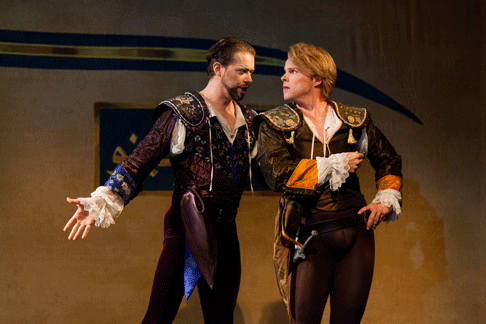 Olivier Laquerre as Chevalier Ubalde and Colin Ainsworth as Renaud
Olivier Laquerre as Chevalier Ubalde and Colin Ainsworth as Renaud
Jeannette Lajeunesse Zingg has choreographed a never-ending, prolific series
of numbers that melded stylized court dances, classical ballet, and suggestions
of primitive tribal dances. The fluid, stage-filling movement from the
seventeen dancers of Opera Atelier was a major asset but also proved a bit
repetitive, and ultimately a bit too placid and polite considering what’s at
stake in the unfolding story. The athleticism of the men’s choreography was
arguably the more interesting with the sword ‘pas de deux’ quite skillfully
done. To be fair, the ladies’ dance with castanets and bells offered nice
variety. Side bar: the men pulling little scimitars out of their little
scabbards and brandishing them as they jetÈe’d off to battle was about as
threatening as “Ballerinos with Butter Knives.”
Marshall Pynkoski’s contribution as director was a series of pleasant
stage pictures, sound traffic management, and melodramatic poses, all
fluttering hands and deliberate gestures. While I admired the consistency, the
approach was occasionally limiting although there was good development o
character relationships and uninhibited intimacy. Overall, Mr. Pynkoski used
all the stage areas with good variety and developed an effective series of
couplings (and un-) for his principals.
Peggy Kriha Dye sang quite an impressive Armide. Her secure soprano easily
dispatched the role’s rangy demands, notably more vibrant at fuller volumes.
Below mezzo forte the tone tended to veer a little to the dry side.
What Ms. Dye’s instrument may lack in natural gradations of color in the
lyric segments, she more than makes up for with good French diction and a calm
sense of line. But when she got riled up in Act Two, Peggy invested heavily in
the emotional content (occasionally at her vocal peril) with a rasp here, a
strident chest tone there, a ferocity of output that pushed the voice almost
beyond its limit. Still, all this risk-taking and decision-making produced
compelling results, drew us into her plight, and earned her a vociferous
reception at curtain call.
Although no announcement was made, I wondered if young, handsome Colin
Ainsworth (Renaud) might not have been indisposed. The basic core of his voice
suggested a sweet lyrical tenor. But the top was often cloudy, the middle and
low were somewhat barked, and the voice just didn’t respond the way he
wanted, especially above the staff. His performance was highly musical and he
husbanded his resources well, but it seemed as though he was making his way
around some limitations by sheer force of will. He showed a pleasing enough
musical approach that I would look forward to hearing him again on another
occasion.
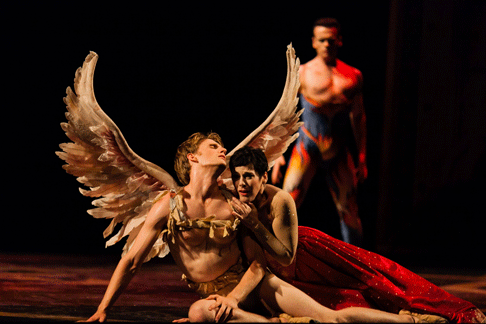 Jack Rennie as Love with Peggy Kriha Dye as Armide and Curtis Sullivan as Hatred
Jack Rennie as Love with Peggy Kriha Dye as Armide and Curtis Sullivan as Hatred
Perhaps the two most exciting singers in the production were the Young
Artists Mireille Asselin (PhÈnice/Lucinde) and Meghan Lindsay
(Sidonie/WaterNymph). Ms. Asselin sports a most refined singing technique, a
lilting silvery tone, and poised delivery. Ms. Lindsay’s winning soprano is
warm and round, yet can be incisive when required.
Olivier Laquerre (ArtÈmido/Ubalde) and Aaron Ferguson (Chevalier) shared
some successful accomplishments as well as some weaknesses. Mr. Laquerre is a
pleasing actor who cuts a good , lithe figure, and Mr. Ferguson matches him for
on-stage presence, abandoned impersonations, and spot-on timing. Their comic
relief scene was faultlessly played and the two were audience favorites.
Unfortunately, their vocal delivery was marred by uneven vocal production,
limited by a weak sense of line and inconsistent focus.
Thomas Cannon has a forceful throbbing voice to be sure, but he pushed his
brief scene as Aronte so hard that tuning was problematic. A bit of restraint
should fix that right up since he performed commendably in Stars.
Curtis Sullivan offered a stalwart portrayal as Hate, with a straight-ish, open
tone, his delivery consistent throughout the range. As Hidraot, Jo„o Fernandes
used his pleasantly darkened baritone to good effect, but he might incorporate
a bit more ‘point’ to truly register as the imposing sorcerer. His singing
lost presence when he sang from upstage, which might have been corrected by
more advantageous placement.
For all the assembled talent on stage, I felt overall that “Armide”
lacked inner life, which must be placed on conductor David Fallis ,who led a
competent but uninspired reading. Orchestral coloration and dramatic engagement
were in short supply, there were some decidedly scrappy ensemble passages
between pit and stage, and there was an overall lack of artistic collaboration.
Pity, since there was such a good roster of talent involved.
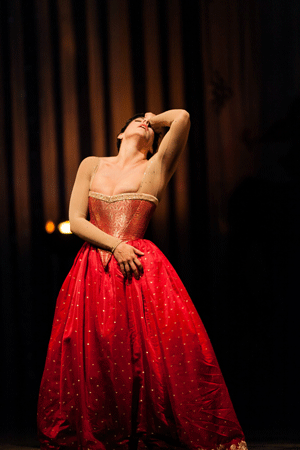 Peggy Kriha Dye as Armida
Peggy Kriha Dye as Armida
I love The Music Man. It is the first live musical I ever saw, and
in college we ‘theatre geeks’ prided ourselves on learning all the
‘rap’ segments by heart. I can still do a pretty mean one man show version
of the “Rock Island” opening. I have directed it twice. So, it was with
some trepidation that I settled in my seat to hear a bunch of classical singers
take on some of musical theatre’s best known characters. My worries were
unfounded.
If Dwayne Croft’s spoken lines were at first a little bit ‘opera house
grand,’ my ear attuned to it, and his assured performance nailed the laughs
and captured the sentiment. Of course he is a fine baritone with a big,
burnished tone and this was likely the best sung Harold Hill on record. But I
was unprepared for his spontaneity, his sense of fun, his fleetness of foot,
and his immersion in the style. A hometown boy, Dwayne started off performing
on Cooperstown stages in musical comedy and well, he still has it in him.
As Marion, Elizabeth Futral was as lovely as ever and sang with her usual
heart and resonant tone. She seemed misdirected to be unwaveringly harsh in Act
One, and her aggressive , level speaking voice did not welcome us to embrace
her as we might. Also, when her singing took over there was a somewhat jarring
gearshift from sassy retort to rich, mellow outpourings. A softening of edges
might make Ms. Futral’s impersonation even more effective.
Jake Gardner landed every punch line as he dithered and blathered
delightfully as the bumbling Mayor Shinn. Josh Walden was a wiry, animated
Marcellus, who proved himself a stellar hoofer. Cindy Gold was a
saltier-than-usual Mrs. Paroo, relishing her ribald references. Megan Ort and
Allan K. Washington were well paired as Zaneeta and Tommy. Ernestine Jackson
brought a fresh new take to Eulalie Mackecknie Shinn. And as Amaryllis and
Winthrop, the youngsters Aria Maholchic and Henry Wager performed like old
pros, the latter stopping the show with “Gary, Indiana”. Master Wager also
touched our hearts with the important transition scene late in Act I when the
shy boy-with-the-lisp suddenly effuses about being handed his new trumpet.
(“Sister, sister, did you ever see such a scrumptious solid gold
thing?”)
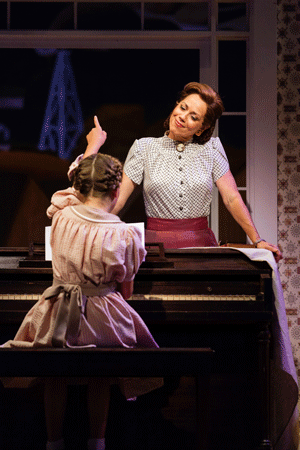 Elizabeth Futral as Marian Paroo with Aria Maholchic as Amaryllis
Elizabeth Futral as Marian Paroo with Aria Maholchic as Amaryllis
The rest of the large cast was filled out with the fresh-scrubbed,
full-voiced Young Artists who sang the choral pieces with panache (David Moody,
chorus master again). Special mention goes to the barbershop quartet: Eric
Bowden, Adam Bielamowicz, John David Boehr, and Derrell Acon. This is a very
specific style of singing and blending, and the four talented young men
skillfully brought it off.
Once one accepted the updating of the action to the 1940’s, the physical
production could hardly be faulted. There were several spectacular show drops
of the sort you hardly see any more, a marvel of a rotating and unfolding set
(designer James Noone) that looked handsome and was exceptionally fluid. Leon
Wiebers has created a lavish parade of colorful costumes that captured the
period beautifully, although I would have preferred that Marion not be in pants
for her first scenes. I appreciate the thought of reinforcing her outsider
status but it distanced the audience as well as the other “citizens.” Kevin
Adams’ atmospheric and vivid lighting enhanced every moment, and there was
excellent work from the follow spots.
Conductor John DeMain was the sure hand in the pit that kept matters humming
along like a well-oiled top. Marcia Milgrom Dodge did yeoman (yeo-woman?) duty
as director and choreographer. Her inventive staging conveyed an impression of
graceful fluidity from start to finish. The updating mostly worked, with some
effective re-imaging like the biddies rolling on seated under hair dryers at
the beauty salon in the spin-up to “Pickalittle.” It worked less well with
the Wells Fargo Wagon being a motor vehicle, since the horses hooves are so
well characterized in the score. And, keeping Harold as a Conservatory graduate
of ‘aught-six’ would make him about sixty-two, past the sell-by date as the
‘usual’ leading man status!
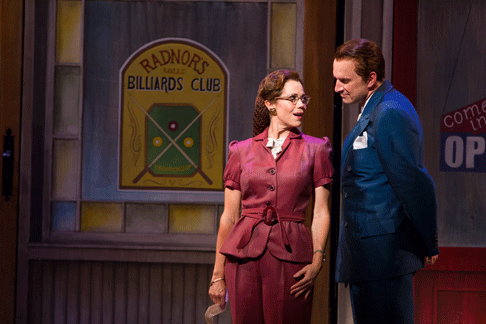 Elizabeth Futral as Marian Paroo and Dwayne Croft as Harold Hill
Elizabeth Futral as Marian Paroo and Dwayne Croft as Harold Hill
The discussion will surely continue whether Broadway musicals with opera
stars belong in a “classical” festival. As I listened to the ripples of
delighted laughter and the outbursts of spontaneous applause; reveled in
hearing un-amplified performers reminding me of the joys of The Music
Man; and considered the SRO audience that included many children, I
thought. . .”and what’s the discussion”?
James Sohre
Aida
Ramfis: Joseph Baron; Radames: Noah Stewart; Amneris: Daveda Karanas; Aida:
Michelle Johnson; King: Philip Gay; Messenger: Clay Hilley; High Priestess:
Lenora Green; Amonasro: Eric Owens; Conductor: Nader Abbassi; Director:
Francesca Zambello; Set Design: Lee Savage; Costume Design: Bibhu Mohapatra;
Lighting Design: Robert Wierzel; Choreographer: Eric Sean Fogel; Hair and
Make-up Design: Anne Ford-Coates; Chorus Master: David Moody
Lost in the Stars
The Leader: Sean Panikkar; Answerer: Bongiwe Nakani; Nita: Chebet Too; Grace
Kumalo: Ernestine Jackson; Stephen Kumalo: Eric Owens; Arthur Jarvis: Ryan
McConnell; James Jarvis: Wynn Harmon; Edward Jarvis: Jonah Groom; John Kumalo:
Amos Nomnabo; Linda: Chrystal E. Williams; Absalom: Makudupanyane Senaoana;
Irina: Brandy Lynn Hawkins; Judge: Jake Gardner; Alex: Caleb McLaughlin;
Conductor: John DeMain; Director: Tazewell Thompson; Set and Costume Design:
Michael Mitchell; Choreographer: Anthony Salatino; Hair and Make-up Design:
Anne Ford-Coates; Chorus Master: David Moody
Armide
PhÈnice/Lucinde: Mireille Asselin; Sidonie/WaterNymph: Meghan Lindsay;
Armide: Peggy Kriha Dye; Hidraot: Jo„o Fernandes; Aronte: Thomas Cannon;
ArtÈmido/Ubalde: Olivier Laquerre; Renault: Colin Ainsworth; Hatred: Curtis
Sullivan; Chevalier: Aaron Ferguson; Conductor: David Fallis; Director:
Marshall Pynkoski; Choreographer: Jeannette Lajeunesse Zingg; Set Design:
Gerard Gauci; Costume Design: Dora Rust D’Eye; Lighting Design: Bonnie
Beecher; Hair and Make-up Design: Anne Ford-Coates; Chorus Master: David
Moody
The Music Man
Charlie Cowell: Wynn Harmon; Conductor/Constable Locke: Aaron Ferguson;
Harold Hill: Dwayne Croft; Mayor Shinn: Jake Gardner; Jacey Squires: Eric
Bowden; Ewart Dunlop: Adam Bielamowicz; Oliver Hix: John David Boehr; Olin
Britt: Derrell Acon; Marcellus Washburn: Josh Walden; Tommy Djilas: Allan K.
Washington; Marian Paroo: Elizabeth Futral; Mrs. Paroo: Cindy Gold; Amaryllis:
Aria Maholchic; Winthrop: Henry Wager; Eulalie Mackecknie Shinn: Ernestine
Jackson: Zaneeta Shinn: Megan Ort; Gracie Shinn: Victoria Munro; Alma Hix:
Samantha Korbey; Maud Dunlop: Lisa Williamson; Ethel Toffelmeier: Stephanie
Lauricella; Mrs. Squires: Amanda Opuszynski; Conductor: John DeMain; Director
and Choreographer: Marcia Milgrom Dodge; Set Design: James Noone; Costume
Design: Leon Wiebers; Lighting Design: Kevin Adams; Hair and Make-up Design:
Anne Ford-Coates; Chorus Master: David Moody
image=http://www.operatoday.com/Aida_Glimmerglass01.gif
image_description=Michelle Johnson as Aida and Eric Owens as Amonasro in Aida. [Photo: Karli Cadel/The Glimmerglass Festival]
product=yes
product_title=Glimmerglass Gambles and Wins
product_by=By James Sohre
product_id=Above: Michelle Johnson as Aida and Eric Owens as Amonasro in Aida.
All photos by Karli Cadel/The Glimmerglass Festival